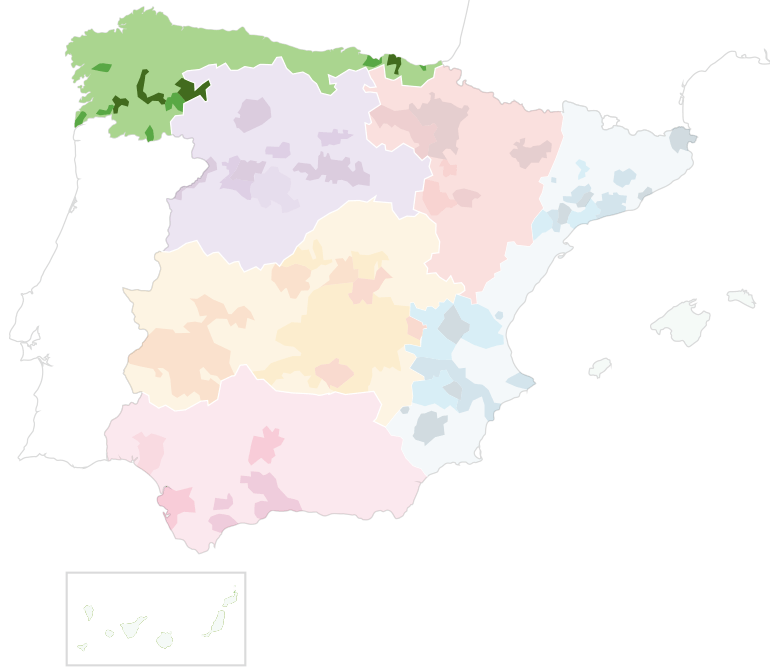You are here

Green Spain
Green Spain’s cool and misty climate necessitates a focus upon earlier-ripening grapes, especially white varieties. Aromatic varieties prosper, with Albariño the most visible success in international markets. Grown along the coast, or along the rivers that give Rias Baixas (“lower fjords”) its name, Albariño is the dominant grape; it can vary from crisp and tangy to round and peachy. While Treixadura and Loureiro grow there too, Rias Baixas’ single-minded focus upon Albariño has fueled a drive that has seen the U.S. become the region’s number one market.
Other white grapes fill the vineyards moving inland; the rich and even complex Godello grape rules in Valdeorras (the “valley of gold”, reflecting Rome’s interest in the place 2000 years ago). Godello, Treixadura and others serve the regions of Monterrei and the picturesque DOs of Ribeiro and Ribeira Sacra. But away from the coast temperatures rise, so red grapes do well too; the Mencia grape is arguably northwest Spain’s best red. Its lip-smacking raspberry tones and floral aromas are fun and bracing.
It was at the beginning of the 80´s when a group of wine producers formed the Txakoli Winemakers´ Association (BIALTXA) and with support from the local Basque administration (the Basque Government and the Biscay Provincial Government), the recovery of this exquisite and unique libation was begun.
The result of all this work and collaboration came about in 1994 with the appellation contrôlée entitled “Chacolí de Vizcaya – Bizkaiko Txakolina” (Txakoli de Bizkaia).
It was at the beginning of the 80´s when a group of wine producers formed the Txakoli Winemakers´ Association (BIALTXA) and with support from the local Basque administration (the Basque Government and the Biscay Provincial Government), the recovery of this exquisite and unique libation was begun.
The result of all this work and collaboration came about in 1994 with the appellation contrôlée entitled “Chacolí de Vizcaya – Bizkaiko Txakolina” (Txakoli de Bizkaia).
The Basque Country’s fresh, white wine, called txakoli on home ground and chacolí elsewhere in Spain, is produced in the region’s three provinces. The DO, which encompasses the growing area in the province of Guipuzcoa (Gipuzkoa), is called Getariako Txakolina in Basque and has 402 hectares devoted to vineyards. Consisting mostly of trained vines, 90% of them are located in coastal areas.
In 1989 the Chacolí from Guetaria (only produced in Aya, Guetaria y Zarauz) was recognised as a Designation of Origin with the name Getariako Txakolina. And in 2007 the Getariako Txakolina Designation expanded its geographical area to the whole of the province of Guipuzcoa.
Monterrei DO takes its name from Monterrey, meaning the king's mountain in Castilian. Monterrei is the Galician spelling. The hilltop fortress still overlooks the vineyards, which run south and north of the road where it runs from Madrid to Galicia, close to the Portuguese border.
The area was awarded DO status late, in 1996, although it had won provisional DO status in the 1970s.
The spectacular success of Rías Baixas' fragrant, fruity white wines since winning DO status in 1988 has given Galician winemaking a new spirit of optimism.
The harnessing of modern technology has also been a key influence in the region's other DOs. Producers range from modern cooperatives to small-scale artesanal producers- here called adegas, the Galician name for bodegas- some of whom now make 'signature' wines of astonishing quality and complexity.
Ribeiro is a traditional growing area, and has been a registered DO since 1932. Today, the area is undergoing a renaissance thanks to the distinctively different wines it makes with native red and white grapes.
Immense innovation and investment is now evident throughout the DO, both in the large cooperatives and in the smaller bodegas. An unusual feature of the area is the many small, independent producers, called colleteiros, who make wine traditionally from their own grapes.
The Ribeira Sacra is one of Spain's most spectacularly beautiful vineyard areas. Its vines are planted in the steep valleys and precipitous gorges of the Rivers Miño and Sil as they wind through Galicia's lush green countryside.
Spiced wines from Amandi, one of the DO's subzones, are legendarily said to have been shipped to classical Rome along with the lamprey from the River Miño to be served at emperors' tables.
Valdeorras DO is a pocket of eastern Galicia shaped by the River Sil, which cuts a long east-west corridor between sierras sheltering vines planted on the slopes above the towns in the valley.
Known for its wines in classical times, Valdeorras has made huge strides in recovering its native grapes - in particular, Godello, and, to a lesser extent, Mencía - in the last thirty years and in making distinctive varietal wines from them.








